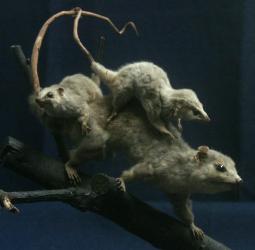
AMERICAN
MARSUPIALS
SUPER COHORT MARSUPIALIA
COHORT AMERIDELPHIA
The American marsupials are now assigned to two families, the
Didelphidae (the opossums), Order Didelphimorphia,
which occur in both North and South America,and the Caenolestidae
(the shrew opossums), Order Paucituberculata,
found only in South America.
We have some specimens of the family
Didelphidae.
American marsupials continue to thrive in competition
with placental mammals and exploit a wide range of diets, being fruit-eating,
carnivorous, insectivorous, ant-eating,
or grazing animals, and habitats, e.g. being arboreal,
terrestrial or burrowing,
The Monito del Monte which lives in Chile was once thought to be related to American marsupials but is now considered to be the only livingmember of the otherwise extinct Order Microbiotheria.
ORDER DIDELPHIMORPHIA
FAMILY DIDELPHIDAE


The 75 species
in this family range from the very small fat-tailed opossum, only 100
grams in weight, to the larger Common Opossum, weighing 12 kg. Didelphids
are widely distributed in the Americas, but are most diverse in the tropics
of South America, from deserts to alpine regions and wet tropical forests.
Most of the family are arboreal, spending most of their time in trees.Their
hearing is thought to be very important as didelphids hunt in the dark and
many have enlarged ears. Olfaction is also important in prey location. During the breeding season male didelphids generally become more active,whereas females become more sedentary, probably to conserve energy to build up the fat reserves needed to produce milk for the young.
The Common or Virginia Opossum, Didelphis virginianaThe Virginia Opossum is the commonest didelphid. It lives in many different habitats - ranging from urban areas to forests - in North and South America. Opossums are about the size of domestic cats.They generally have white heads with brown/black, coarse fur. The males are larger than the females.Like most marsupials they are nocturnal, but forage during the day in winter. They have long, scaly, prehensile tails which help them to climb; contrary to belief they cannot hang by their tails due to their size. When the climate becomes cold, they may go into a state of torpor. Virginia opossums are omnivorous, feeding
on arthropods, fruit, leaves, carrion and rodents. Their 50 teeth
(I5/4; C1/1; PM3/3; M4/4)
help them
eat this wide of food. Their opposable thumbs enable them to manipulate
their food with ease and grasp branches when climbing. These opossums breed twice a year, between January and February, and in August.
Their litters of 8 - 10 young are born 12 - 14 days after conception.
They are carried in the pouch for 2 - 3 months, after which they ride on
their mother's back for another 1 - 2 months. They become sexually mature
at 6 months. Only the female rears the young as this opossum is a solitary
species, with individuals only coming together for the breeding season.
The female stays in her home range for life. The male has a semi-permanent
home range, depending on the abundance of food. Virginia opossums are generally placid, but if threatened hiss and growl and bare their teeth. Thay also produce a particularly unpleasant scent to ward off predators, such as owls, coyotes, dogs and man. Opossums are slow-moving and fairly easy prey, so they tend only to live for 1 - 2 years in the wild due to predation and collisions with cars. In captivity they may live for up to 10 years. |
 
|
Arboreal Didelphids, mouse and woolly opossumsThe morphology, behaviour and diets of arboreal didelphids resembleprosimian primates. They are all predominantly nocturnal. Their big toes are opposable and their prehensile tails allow them to grasp onto branches leaving their hands free to forage. The slow movement and diet, fruit, nectar and gum, of woolly opossums resembles those of Lorises.Up to seven species of didelphids may live in one tree, as seen in different species of primates. Competition is avoided through differences in size and climbing abilities. Some, such as the woolly opossums, live high in the tree canopies, feeding solely on fruit and nectar. Others, such as the common mouse opossum, live and feed in the middle canopy or the lower regions of the trees.Some become terrestrial in times of high competition. Ground-dwelling didelphids may eat carrion and live vertebrates, including small mammals. |  |
The Yapok or Water Opossum Chironectes minimusThe Yapok is the only truly aquatic marsupial. It has adapted to an aquatic life by losing some of the opposability in its thumb and having webbed feet that enable it to move swiftly in water. Both male and female yapoks have pouches.The female's pouch forms a water-tight compartment which protects her offspring when she dives; the male's scrotum can be pulled into his pouch allowing him to move more swiftly in water. The yapoks' diet has not been studied extensively, but they are believed to be both insectivorous and omnivorous, feeding opportunistically on animals such as cray-fish. Yapok's breed between January and December and raise litters of 1 - 5 offspring. They are anti-social animals, the sexes only come together to breed. The young leave the pouch after 48 days but remain close to their mother. Yapoks are not believed to be endangered. |
|
| INTRODUCTION TO MARSUPIALS | AUSTRALIAN MARSUPIALS | MONOTREMES |







